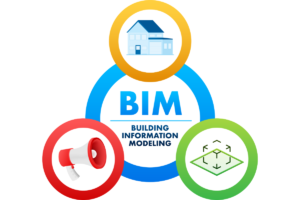What is BIM?
Building Information Modeling, or BIM, is a digital process that involves the creation and management of 3D models to support construction projects. BIM enables companies to visualize projects before they even begin, improving the design, planning, and execution stages. Unlike traditional design methods, BIM integrates layers of information into a single model, allowing real-time collaboration and seamless project coordination.
Why is BIM Important for Modern Companies?
The construction and engineering industries are fast-paced and highly competitive. Adopting BIM can set companies apart by enhancing efficiency, reducing costs, and minimizing errors. Additionally, BIM is becoming the industry standard, with many government and private projects mandating its use.
Benefits of BIM for Companies
Enhanced Collaboration and Communication
BIM provides a central platform for all project stakeholders—architects, engineers, contractors, and clients—to collaborate. Real-time updates and shared models ensure everyone is on the same page, reducing miscommunication and delays.
Improved Project Efficiency and Accuracy
By identifying potential issues early through 3D modeling and simulations, BIM helps reduce costly on-site errors. Companies using BIM report faster project timelines and fewer resources wasted on rework.
Assessing Your Company’s Readiness for BIM
Evaluating Current Digital Capabilities
Before diving into BIM, assess your company’s existing technology infrastructure. Ensure that your hardware and software can support BIM tools, as the technology is data-intensive and requires robust systems.
Analyzing Employee Skill Sets
BIM adoption requires skilled personnel. Evaluate whether your team has the necessary expertise, or if training will be required. This assessment helps identify gaps and prepares your team for the transition.
Setting Clear Goals for BIM Implementation
Defining Success Metrics
Determine what success looks like for your company’s BIM adoption. Whether it’s a 20% reduction in project costs or a faster completion rate, having measurable goals will guide your transition.
Determining Project-Specific Objectives
Each project has unique requirements. Tailor BIM goals to the specific demands of each project, such as reducing design errors or improving coordination.
Choosing the Right BIM Software
Popular BIM Software Options
Some of the most popular BIM tools include Autodesk Revit, ArchiCAD, and Bentley Systems. These tools vary in features and capabilities, so choose one that aligns with your project needs and budget.
Factors to Consider When Choosing BIM Software
Consider factors like ease of use, integration capabilities, and customer support. The right BIM software should be compatible with other tools in your company’s workflow, making the transition smoother.
Building a BIM Implementation Team
Key Roles in a BIM Team
Successful BIM implementation requires a dedicated team. Key roles include a BIM Manager, modelers, coordinators, and IT support. Each member plays a crucial part in setting up and maintaining BIM processes.
Training and Skill Development
BIM requires specialized skills, so provide training programs for your team. Certifications and courses on BIM software can enhance your team’s knowledge and efficiency.
Developing a BIM Implementation Plan
Phased Implementation Approach
Implementing BIM in phases allows your company to adjust and adapt. Start with pilot projects to understand the technology and refine processes.
Pilot Projects and Testing
Select a small, manageable project as a BIM pilot. This approach allows you to test BIM’s effectiveness and gather feedback before a full-scale rollout.
Investing in Training and Skill Development
BIM Training Programs for Employees
Investing in training programs ensures your team is ready for the transition. Look for certified BIM courses or partner with BIM experts to provide hands-on training.
Encouraging Ongoing Learning
BIM technology is constantly evolving. Encourage your team to pursue continuous learning to stay updated with new tools and techniques.
Integrating BIM with Existing Processes
Identifying Compatibility with Current Systems
Assess whether BIM tools can integrate with your current systems. This includes software compatibility, file formats, and data transfer processes.
Streamlining Workflow Integration
Make adjustments to your workflows to accommodate BIM. Redefine roles and processes where necessary to ensure a smooth integration.
Data Management and Security in BIM
Establishing Data Standards
Define data standards to maintain consistency across BIM models. Standardized data management practices help in organizing and storing BIM files securely.
Ensuring Data Security and Compliance
Data security is crucial when dealing with digital models. Implement access controls and follow industry regulations to protect sensitive project information.
Overcoming Common BIM Adoption Challenges
Addressing Resistance to Change
Adopting BIM can be met with resistance from employees comfortable with traditional methods. Promote the benefits of BIM and involve staff in the transition process to gain their support.
Managing the Learning Curve
BIM has a steep learning curve. Provide adequate training, patience, and support to help employees adapt to the new system.
Collaborating with Stakeholders
Internal Collaboration Across Departments
BIM thrives on collaboration, so promote communication across departments. Involve all stakeholders, from design teams to project managers, to maximize BIM’s effectiveness.
External Partnerships and Vendor Communication
BIM projects often involve external vendors. Ensure they’re also aligned with BIM standards to maintain project continuity and accuracy.
Measuring the Success of BIM Implementation
Key Performance Indicators (KPIs) for BIM Success
Track KPIs such as cost savings, time efficiency, and project quality. These metrics provide a clear picture of BIM’s impact on your operations.
Tracking ROI and Benefits
Calculate the return on investment (ROI) of BIM. Consider both tangible and intangible benefits, such as client satisfaction and error reduction.
Scaling BIM for Future Projects
Expanding BIM Across More Projects
Once BIM is successful in initial projects, expand its usage. Integrate BIM into larger projects to fully realize its potential.
Adjusting Strategies Based on Feedback
Review feedback from each BIM project to refine strategies. This iterative process helps you improve BIM implementation over time.
The Future of BIM in Your Company
Transitioning to BIM can be a game-changer for your company. With careful planning, the right tools, and an invested team, BIM can transform how you approach projects, ultimately leading to enhanced productivity and client satisfaction. Adopting BIM may seem challenging, but the benefits far outweigh the initial investment. Embrace BIM as a tool for innovation and efficiency in the modern construction landscape.





